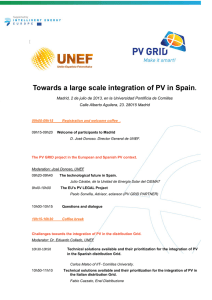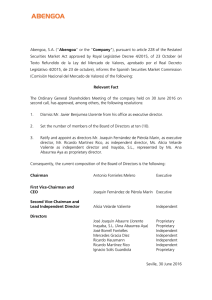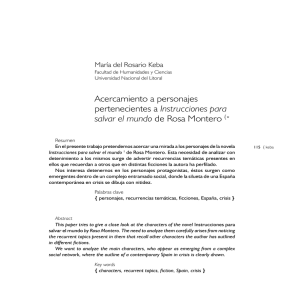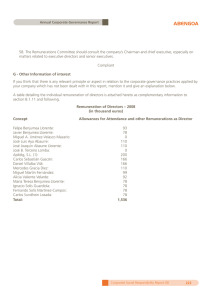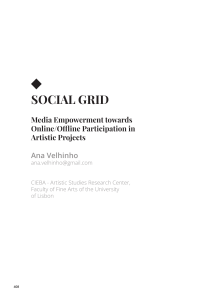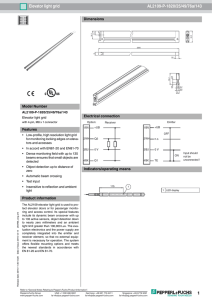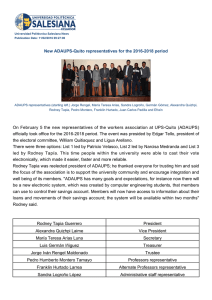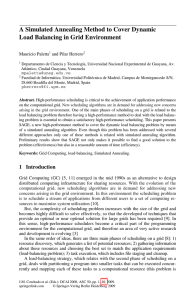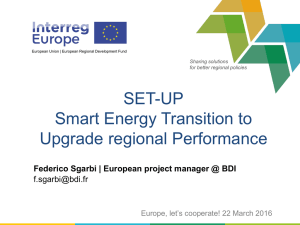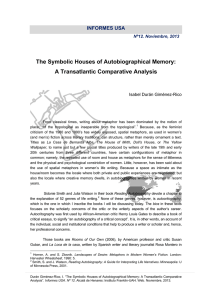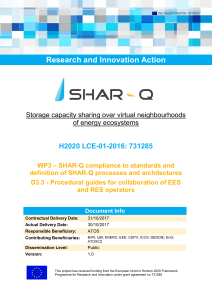Grid4Utility: A Grid Infrastructure for Utility Computing TIN2006
Anuncio
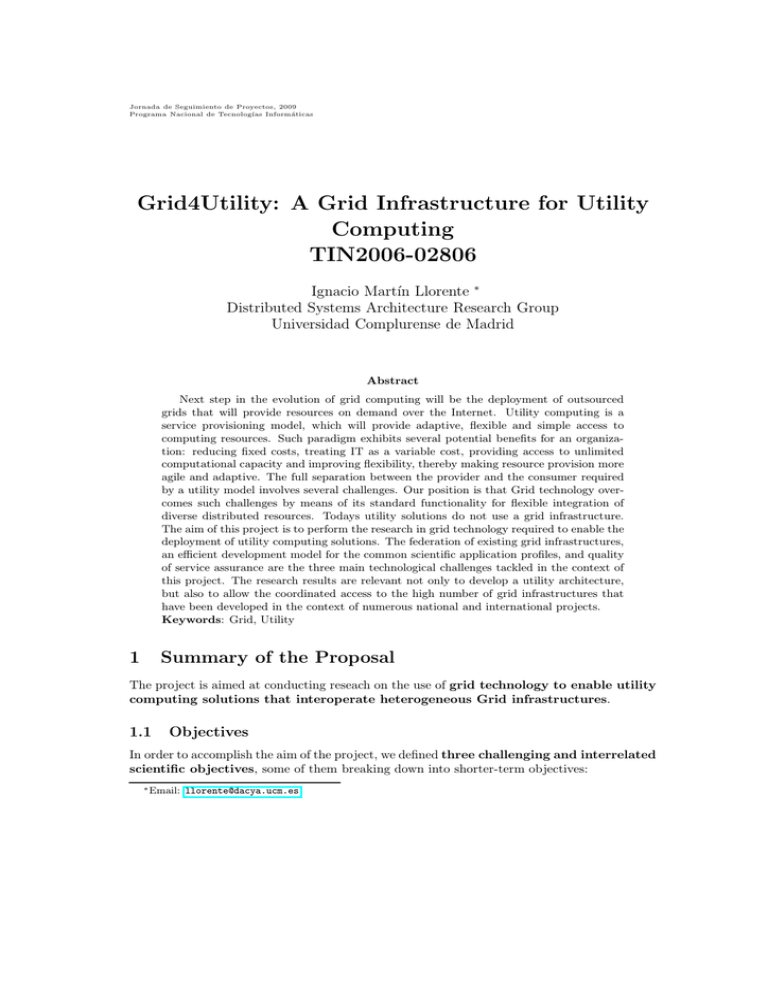
Jornada de Seguimiento de Proyectos, 2009 Programa Nacional de Tecnologı́as Informáticas Grid4Utility: A Grid Infrastructure for Utility Computing TIN2006-02806 Ignacio Martı́n Llorente ∗ Distributed Systems Architecture Research Group Universidad Complurense de Madrid Abstract Next step in the evolution of grid computing will be the deployment of outsourced grids that will provide resources on demand over the Internet. Utility computing is a service provisioning model, which will provide adaptive, flexible and simple access to computing resources. Such paradigm exhibits several potential benefits for an organization: reducing fixed costs, treating IT as a variable cost, providing access to unlimited computational capacity and improving flexibility, thereby making resource provision more agile and adaptive. The full separation between the provider and the consumer required by a utility model involves several challenges. Our position is that Grid technology overcomes such challenges by means of its standard functionality for flexible integration of diverse distributed resources. Todays utility solutions do not use a grid infrastructure. The aim of this project is to perform the research in grid technology required to enable the deployment of utility computing solutions. The federation of existing grid infrastructures, an efficient development model for the common scientific application profiles, and quality of service assurance are the three main technological challenges tackled in the context of this project. The research results are relevant not only to develop a utility architecture, but also to allow the coordinated access to the high number of grid infrastructures that have been developed in the context of numerous national and international projects. Keywords: Grid, Utility 1 Summary of the Proposal The project is aimed at conducting reseach on the use of grid technology to enable utility computing solutions that interoperate heterogeneous Grid infrastructures. 1.1 Objectives In order to accomplish the aim of the project, we defined three challenging and interrelated scientific objectives, some of them breaking down into shorter-term objectives: ∗ Email: [email protected] TIN2006-02806 Figure 1: Work plan. A.1. Programming models for utility computing infrastructures to enable the efficient porting of the most common application profiles A.2. Alternatives for the federation of grid infrastructures to enable the hierarchical deployment of existing grid infrastructures A.2.1. Alternatives for meta-scheduling that consider execution and input/output profiles in the discovery, selection and submission processes A.2.2. Alternatives for information aggregation in different infrastructures to reduce the delay in information update and transferring A.2.3. Alternatives to assure information confidentiality and integrity in resources sharing A.2.4. Alternatives for resource sharing policies among grid infrastructures A.3. Techniques for quality of service provision (QoS) in the grid A.3.1. Alternatives for meta-scheduling based on quality of service parameters that consider resource interconnection performance, being able to interface to network components A.3.2. Meta-scheduling of applications on virtual environments in grids and their support for the implementation of SLAs (Service Level Agreement) A.3.3. Quality of service to execute multimedia applications on the grid 1.2 Work Plan and Resources The Work Plan was organized in three interrelated scientific activities, some breaking down into tasks. Two researchers were added to the initial team: Dr. Eduardo Huedo Cuesta and Dr. Jose Luis Vázquez-Poletti; and two researchers have just obtained a PhD degree. 2 Progress Report This section describes for each task the main achievements and related publications. 2.1 2.1.1 A01: Programming Models and Application Evaluation A0101: Programming Models and Application Evaluation DRMAA (Distributed Resource Management Application API) OGF Recommendation has been chosen as programming models for utility computing infrastructures. The GridWay DR- TIN2006-02806 MAA reference implementation provides the final user with a uniform, secure and reliable interface to manage the applications executed on a utility computing infrastructure. • J. Herrera, E. Huedo, R. Montero and I. Llorente , “GridWay DRMAA 1.0 Implementation - Experience Report”, Open Grid Forum, Open Document GFD.104, may 2007 • I. M. Llorente, R. S. Montero, E. Huedo, C. Vázquez, J. L. Vázquez-Poletti, J. Herrera, K. Leal, “GridWay as a Tool for Porting Applications to the EGEE Infrastructure”, 2nd EGEE User Forum, may 2007, UK • I. M. Llorente, R. S. Montero, E. Huedo, C. Vázquez, J. Fontán, H. Herrera and J. L. Vázquez-Poletti, “GridWay Interfaces for On-demand Access to EGEE”, EGEE Conference 2007, october 2007, Budapest, Hungary • R. M. Badia, D. Du, E. Huedo, A. Kokossis, I. M. Llorente, R. S. Montero, M. de Palol, R. Sirvent, and C. Vázquez, “Integration of GRID superscalar and GridWay Metascheduler with the DRMAA OGF Standard”’, EuroPar 2008, Gran Canaria, Spain, 2008, Lecture Notes in Computer Science (LNCS), pp. 445-455, Vol. 2008, Springer Verlag New techniques based on dynamic selection of the task granularity and file locality for the efficient execution of embarrassingly distributed and master-worker execution profiles on heterogenous and dynamic Grid infrastructures. The techniques have been applied for porting Bioinformatics and Physics Fusion applications. • J. L. Garzón , E. Huedo, R. S. Montero, I. M. Llorente and P. Chacón, “Adaptation of a Multi-Resolution Docking Bioinformatics Application to the Grid”, Journal of Software, Vol. 2, N. 2, pp. 1-10, 2007 • J. I. Garzón, E. Huedo, R. S. Montero, I. M. Llorente, and P. Chacón, “Grid Multi-Resolution Docking”, 15th Euromicro Conference on Parallel and Network-based Processing, pp. 3-10, 2007, IEEE Computer Society • F. Castejón, I. Campos, A. Cappa, L.A. Fernández, E. Huedo, I.M. Llorente, V. Martı́n, R.S. Montero, M. Mikhailov, A. Taranc—n, M.A. Tereschenko, J.L. Vázquez-Poletti, J.L. Velasco, V. Voznesensky, “Fusion in the Grid”, Spanish Conference on e-Science Grid Computing, march 2007, Madrid, pp. 141-146, CIEMAT • F. Castejón, I. Campos, J. L. Vázquez-Poletti, J. L. Velasco, V. Voznesensky, A. Cappa, L. A. Fernández, E. Huedo, I. M. Llorente, V. Mart’n, R. S. Montero, M. Mikhailov and A. Tarancón, “Status of Fusion Activities in the Grid”, 2nd EGEE User Forum, may 2007, Manchester, UK • L. Vázquez-Poletti, E. Huedo, R. S. Montero, I. M. Llorente, A. Cappa, M. Tereshchenko and F. Castejón, “MARATRA: A Production Fusion Physics System”, 2nd EGEE User Forum, may 2007, Manchester, UK • F. Castejón, J.L. Velasco, A. Tarancón, J. L. Vázquez-Poletti, V. Voznesensky, M. Tereshchenko and A. Cappa, “Fusion Results within EGEE”, 3rd EGEE User Forum, Clermont-Ferrand, France New agglomeration and replication techniques for optimizing the execution of workflows on top of dynamic heterogeneous Grid infrastructures. The techniques have been evaluated in the porting of the Bioinformatics CD-HIT application. • J.L. Vázquez-Poletti, E. Huedo, R.S. Montero and I.M. Llorente, “Workflow Management in a Protein Clustering Application”, Seventh IEEE International Symposium on Cluster Computing and the Grid - CCGrid 2007, Conference Proceedings, pp. 679-684, IEEE Computer Society Press • J. L. Vázquez-Poletti, E. Huedo, R. S. Montero, I. M. Llorente, J. M. Fernández and A. Valencia, “Protein Clustering on the EGEE”, 2nd EGEE User Forum, may 2007, Manchester, UK • J. L. Vázquez-Poletti, E. Huedo, R. S. Montero, I. M. Llorente, J. M. Fernández and A. Valencia, “Protein Clustering with CD-HIT on the EGEE”, 8th Spanish Symposium on Computational Biology, february 2008, Valencia, Spain • J. L. Vázquez-Poletti, E. Huedo, R. S. Montero and I.M. Llorente, “Advanced Strategies for Efficient Workflow Management in a Protein Clustering Application with GridWay”, 1st Iberian Grid Infrastructure Conference, may 2007, Santiago de Compostela, Spain, Conference Proceedings, pp. 1991-207, CESGA • J. L. Vázquez-Poletti, E. Huedo, R. S. Montero and I. M. Llorente, “Replication Heuristics for Efficient Workflow Execution on Grids”, Intl. Conf. Grid computing, high-performAnce and Distributed Applications, GADA 2007, Vilamoura, Portugal, Lecture Notes in Computer Science (LNCS), Vol. 4805, pp. 31-32. • J.L. Vázquez-Poletti, E. Huedo, R.S. Montero and I.M. Llorente, “CD-HIT Workflow Execution on Grids using Replication Heuristics”, Workshop on Modern Computer Tools for the Biosciences 2008, 8th IEEE International Symposium on Cluster Computing (CCGRID2008), Lyon, France, pp. 735-740, IEEE Computer Society Press • J.L. Vázquez-Poletti, E. Huedo, R.S. Montero, I.M. Llorente, J. M. Fern‡ndez and A. Valencia, “Protein Clustering with CD-HIT on Grid environments’, under review at Bioinformatics A new scheduling algorithm to distribute tasks and loops on heterogenous and dynamic Grid environments has been developed. The algorithm is an enhancement of the distributed dynamic self-scheduler algorithm used in loop parallelization that takes into account all Grid characteristics: a high degree of heterogeneity, high fault rate, dynamic resource availability, etc. The algorithm has been applied to the efficient execution of Physics Fusion simulation codes. • J. Herrera, E. Huedo, R. S. Montero and I. M. Llorente, “Ejecución Distribuida de Bucles en Grids Computacionales”, Boletı́n de RedIris 80, pp. 52-56, Abril 2007, Centro de Comunicaciones CSIC/ RedIRIS, Spain • J. Herrera, E. Huedo, R. S. Montero and I. M. Llorente, “Distributed Task Scheduling for Physics Fusion Applications”, 3rd EGEE User Forum, february 2008, Clermont-Ferrand, France TIN2006-02806 2.2 2.2.1 A02: Architectures for the Federation of Grid Infrastructures A0201: Meta-scheduling among Grid Infrastructures We have proposed and evaluated an innovative architecture for utility computing, based on Grid federation, which can be easily deployed on any infrastructure based on Globus. The publications demonstrate its many advantages in terms of security, scalability and site autonomy, and includes performance results. In order to provide a seamless access to the utility provider from a local cluster, we have also evaluated solutions based on transfer queues. • Tino Vázquez, Eduardo Huedo, Ruben S. Montero and Ignacio M. Llorente, “Evaluation of A Utility Computing Model based on the Federation of Grid Infrastructures”, EuroPar 2007, Rennes, Francia, 2007, Lecture Notes in Computer Science (LNCS), Vol. 4641, pp. 372-381, Springer Verlag • E. Huedo, R. S. Montero and I. M. Llorente, “Infraestructuras grid para utility computing”, Computaci—n Grid: del Middleware, Universidad de Castilla La Mancha • Tino Vázquez, Javier Fontan, Eduardo Huedo, Ruben S. Montero and Ignacio M. Llorente, “Transparent Access to Grid-Based Compute Utilities”, PPAM 2007, Gdansk, Polonia, Lecture Notes in Computer Science (LNCS), Vol. 4967, 2008, pp. 817-824, Springer Verlag • E. Huedo, R. S. Montero and I. M. Llorente, “A Taxonomy of Grid Scheduling Architectures”, under review at IEEE Computer 2.2.2 A0202: Approaches for Information Aggregation Our aim has been to define an efficient scheduling algorithm without requiring monitoring attributes of the resources in the federated Grids. A performance model, previously proposed to characterize the performance of Grid infrastructures with their asymptotic performance and half-performance length, has been extended to evaluate federations of grids. This model allows the definition of new scheduling policies only considering two aggregated performance metrics in order to reduce the total execution time of a workload, while also taking into account resource ownership, to maximize the use of local resources and reduce costs. • C. Vázquez, E. Huedo, R. S. Montero and I. M. Llorente, “A Performance Model for Federated Grid Infrastructures”, 16th Euromicro Intl. Conf. Parallel, Distributed and network-based Processing (PDP 2008), february 2008, Toulouse, France, Proceedings, IEEE Computer Society,pp. 188-192 • C. Vázquez, E. Huedo, R. S. Montero and I. M. Llorente, “Federation of TeraGrid, EGEE and OSG Infrastructures through a Metascheduler”, under review at Future Generation Computing Systems, Elsevier 2.2.3 A0203: Confidentiality and Integrity We have evaluated the security and autonomy implications of the models for federation of Grid infrastructures. The recursive architecture for hierarchical Grids fully hides the federated infrastructure configuration details. Only one machine should be accessible from the Internet with a limited set of services, so drastically reducing security requirements. • J. L. Vázquez-Poletti , E. Huedo, R. S. Montero, e I. M. Llorente, “A Comparison Between two Grid Scheduling Philosophies: EGEE WMS and GridWay”, Multiagent and Grid Systems, pp. 429-439, 2007, IOS Press • I. M. Llorente, R. S. Montero, E. Huedo, T. Váquez y J. L. Vázquez-Poletti, “GridWay: A metascheduler for Globus-based Grids”, 2nd Annual TeraGrid Conf. TeraGrid 2007, june 2007, Madison, WI, USA • E. Huedo, R. S. Montero and I. M. Llorente, “A Recursive Architecture for Hierarchical Grid Resource Management”, Future Generation Computing Systems The International Journal of Grid Computing: Theory, Methods and Applications, 25 (4), pp. 401-405, April 2009, Elsevier TIN2006-02806 2.2.4 A0204: Resource Sharing Policies We are developing new scheduling algorithms to reduce the makespan of the submitted applications, and to increase the performance of the resources at each level in the Grid hierarchy. The new algorithm does not require information on processor speeds and task lengths although those could be used to set the initial objective, and only needs information about the past performance of the resources to predict a new objective. • K. Leal, E. Huedo, R. S. Montero and I. M. Llorente, “Scheduling Strategies in Federated Grids”, 2008 High Performance Computing & Simulation Conference (HPCS 2008), june 2008, Nicosia, Cyprus, ECMS • K. Leal, E. Huedo and I. M. Llorente, “Dynamic Objective and Advance Scheduling in Federated Grids”, Intl. Conf. Grid computing, high-performAnce and Distributed Applications, GADA 2008, Monterrey, Mexico, Lecture Notes in Computer Science (LNCS), pp. 711-725, Vol. 5331, 2008, Springer Verlag • K. Leal, E. Huedo and I. M. Llorente, “A Decentralized Model for Scheduling Independent Tasks in Federated Grids”, under review at Future Generation Computing Systems The International Journal of Grid Computing: Theory, Methods and Applications, Elsevier 2.3 2.3.1 A03: Quality of Service Provisioning in the Grid A0301: Meta-scheduling based on Quality of Service Parameters We have analyzed the application of Quality of Service (QoS) provisioning techniques for Grid resource management, and the adaptation of the meta-scheduler to include QoS parameters. The meta-scheduling policies analyzed are mainly based on two strategies: scheduling based on resource level utilization; and scheduling based on time of use. We have extended the work to wireless networks without infrastructure (ad-hoc networks), by achieving an analysis of the main resource discovering techniques in ad-hoc grids, and we have proposed a hybrid method that improves the efficiency of the existing discovering mechanisms. We have also analyzed the application of other advanced services by modern networks to grid resource management, as multicasting to improve efficiency of file transfers. • R. Moreno, “A Hybrid Mechanism for Resource/Service Discovery in Ad-Hoc Grids”, to appear in the Journal on Future Generation Computer Systems (2008)Elsevier • R. Moreno, “Application Layer Multicast Techniques in Grid Environments”, EATIS 2007 - Euro American Conference on Telematics and Information System. Faro, PORTUGAL. May 2007, ACM Digital Library • Rafael Moreno-Vozmediano, Krishna Nadiminti, Srikumar Venugopal, Ana B. Alonso-Conde, Hussein Gibbins and Rajkumar Buyya, “Portfolio and investment risk analysis on global grids”, Journal of Computer and System Sciences Vol. 73 (2007) pp. 1164-1175, Elsevier • Carlos Castillo-Trello, R. Moreno, “Aplicación de t écnicas multicast para la mejora del sistema de descubrimiento de recursos en Grids”, XVII Jornadas Paralelismo. Albacete, Spain, September 2006 • R. Badı́a et al, “Use-Cases and Requirements for Grid Checkpoint and Recovery”, Open Grid Forum, Open Document GFD.92, may 2007 2.3.2 A0302: Virtual Environments in Grids We have proposed and evaluated in production infrastructures two new approaches to overcome Grid computing limitations due to heterogeneity in the Grid resources and the application configuration demands: (i) an straightforward deployment of custom virtual machines to support the application execution, (ii) and a new architecture to provision computing elements that allows to dynamically adapt them to changing VO demands. • A. J. Rubio, R. S. Montero, E. Huedo and I. M. Llorente, “Straightforward Deployment of XMM-Newton Scientific Analysis Software on Grids with GridWay”, ESA Grid Workshop 2006, october 2006, Madrid, Spain • A. J. Rubio, R. S. Montero, E. Huedo and I. M. Llorente, “Management of Virtual Machines on Globus Grids Using GridWay”, Fourth High-Performance Grid Computing Workshop, 21st IEEE International Parallel and Distributed Processing Symposium, pp. 1-7, 2007, Conference Proceedings, IEEE Computer Society Press TIN2006-02806 • D. Tapiador, A. J. Rubio-Montero, E. Huedo, R. S. Montero and I. M. Llorente, “Two Approaches for the Management of Virtual Machines on Grid Infrastructures”, Spanish Conference on e-Science Grid Computing, march 2007, Madrid, Spain, Conference Proceedings, pp. 72-82, CIEMAT • I. M. Llorente, E. Huedo, R. S. Montero, A. J. Rubio and D. Tapiador, “Using GridWay for the Management of Virtual Machines in the EGEE Infrastructure”, 2nd EGEE User Forum, may 2007, Manchester, UK • M. Rodriguez, D. Tapiador, J. Fontan, E. Huedo, R. S. Montero and I. M. Llorente, “Dynamic Provisioning of Virtual Clusters for Grid Computing”, 3rd Workshop on Virtualization in High-Performance Cluster and Grid Computing (VHPC 08), EuroPar 2008, Gran Canaria, Spain, 2008, Workshop Proceedings, Lecture Notes in Computer Science (LNCS), Springer Verlag • R. S. Montero, E. Huedo and I. M. Llorente, “Dynamic Deployment of Custom Execution Environments in Grids”, The Second International Conference on Advanced Engineering Computing and Applications in Sciences (ADVCOMP 2008), Valencia Spain, October 2008, pp. 33-38, Proceedings, IEEE Computer Society We are also evaluating the challenges in the dynamic and scalable management of virtual machines on a distributed pool of resources. • R. S. Montero, I. M. Llorente et al, “The RESERVOIR Model and Architecture for Open Federated Cloud Computing”, to appear in IBM Systems Journal • B. Sotomayor, R. S. Montero, I. M. Llorente, I. Foster, “Capacity Leasing in Cloud Systems using the OpenNebula Engine”, Workshop on Cloud Computing and its Applications 2008 (CCA08), Chicago, October, 2008 • B. Rochwerger, A. Galis, E. Levy, J. A. Cáceres, D. Breitgand, Y. Wolfsthal, I. M. Llorente, M. Wusthoff, R. S. Montero, and E. Elmroth, “RESERVOIR: Management Technologies and Requirements for Next Generation Service Oriented Infrastructures”, 11th IFIP/IEEE International Symposium on Integrated Network Management, Nueva York, USA, 2008 • R. Moreno, R. S. Montero and I. M. Llorente, “On-Demand Scale-Out of Computing Clusters Using Infrastructure Clouds”, under review at Computer Networks • B. Sotomayor, R. S. Montero, I. M. Llorente and I. Foster, “An Open Source Solution for Virtual Infrastructure Management in Private Clouds”, under review at IEEE Internet Computing • R. Moreno, R. S. Montero and I. M. Llorente, “Elastic provisioning of a web server cluster with cloud resources”, under review at IEEE Internet Computing • R. Moreno, R. S. Montero and I. M. Llorente, “An Elasticity Model of High Throughput Computing Clusters”, under review at IEEE Transactions on Parallel and Distributed Systems • B. Sotomayor, R. S. Montero, I. M. Llorente and I. Foster, “Resource Leasing and the Art of Suspending Virtual Machines”, submitted to the 11th IEEE International Conference on High Performance Computing and Communications (HPCC-09) • R. Moreno, R. S. Montero and I. M. Llorente, “Cloud Computing for on-Demand Grid Resource Provisioning”, submitted to a book on ”Trends in High Performance and Large Scale Computing” 2.3.3 A0303: Quality of Service for Multimedia Application Execution Collaborative and distributed applications such as multimedia must adhere to stringent realtime constraints and quality of service requirements. Since Grids are naturally highly dynamic and heterogeneous environments, we have considered the use of Java to integrate heterogeneous systems from supercomputers to PDAs. In general, the environment must accommodate the embedded small-scale constraints associated with PDAs, and enable the execution of the applications traditionally supported on the desktop such as soft real-time multimedia applications. Although, Java has some shortcomings regarding the real-time requirements; in order to provide solutions for the extension of Java for Distributed Real-time Systems, we have studied how to extend the memory management system provided by the Real-Time Java Specification. • M.T. Higuera-Toledano, “Towards an Extension of Real-Time Java Supporting Several Multimedia Applications”, Proceedings of the 5th ACS/IEEE International Conference on Computer Systems and Applications (AICCSA-07), Conference Proceedings, pp. 521-527, IEEE Computer Society Press • M. T. Higuera-Toledano, “Allowing Cycle’s References among Scoped Memory Areas in the Real-Time Specification of Java”, Proc. of the 10th International Symposium on Object-Oriented Real-Time Distributed Computing (ISORC’07), Conference Proceedings, pp. 110-114, IEEE Computer Society Press • M.T. Higuera-Toledano, “Name-based Write Barriers in Real-Time Java”, IEEE International Conference on Computer and Information Technology, 2007, Conference Proceedings, pp. 781-786, IEEE Computer Society TIN2006-02806 • M. T. Higuera-Toledano, “Allowing Cycle References by Introducing Controlled Violations of the Assignment Rules in Real-Time Java”, Proc. of the 11th International Symposium on Object-Oriented Real-Time Distributed Computing (ISORC’08), pp. 463-467, IEEE Computer Society • M.T. Higuera-Toledano, “Making Stronger and Flexible the Single Parent Rule in the Real-time Specification of Java”, Proceedings of the 6th International Workshop on Java Technologies for Real-time and Embedded Systems, JTRES 2008, Conference Proceedings, pp. 19-28, ACM International Conference Proceeding 3 Measurable Results The project has fully achieved its objectives and technical goals for the period. 3.1 Scientific Outcomes The results of the project have been published in the leading journals and proceedings books: • JCR journals: 4 (+8 under review); Other inter journals: 2; Spanish journals: 1 • LNCS conferences: 6; ACM-IEEE Conferences: 11 (+1 under review) • Other conferences: 4 (+1 under review); Spanish Conferences: 2 • Standardization Documents: 2; Books of Abstracts: 11 The list of publications of the research group is available at dsa-research.org, and the list of additional presentations, seminars and demonstrations about the technology outcomes is available at www.gridway.org/doku.php?id=outreach:outreach. Moreover, the group maintains its own weblog (blog.dsa-research.org) and also publishes posts in GridGurus (gridgurus.typepad.com) in order to disseminate the results of the project. The results have been referenced in more than 300 research publications. 3.2 Technological Outcomes and Technology Transfer The proposal includes technological objectives and milestones for the development of the software prototypes required to do the research, which are being transferred to the industry and the scientific community: • The GridWay Metascheduler (www.GridWay.org) has been enhanced in order to incorporate the new DRMAA bindings for application porting and information and execution drivers for federation of infrastructures using adapters. GridWay is distributed as open-source software under the terms of the Apache license v2.0. Since the beginning of the project in 2007, we have registered 1.822 downloads from 103 different countries and 40.000 visits from 21.000 different visitors. GridWay is also distributed through the Globus distributions, a ”de facto” standard for Grid Computing. GridWay is used in most of the international and regional Grid Infrastructures around the world and in several enterprise Grids (http://www.gridway.org/doku.php?id=success:projects). • We have also developed GridGateWay, with the new execution, information and security components, for federation of Grid infrastructures. These components, available at www.Grid4Utility.org and http://www.gridway.org/doku.php?id=related:transferq, are being used in D-Grid (German Grid Infrastructure) and APAC Grid (Australian Grid Infrastructure). The outcomes are also being used by several research groups as framework to do research on scheduling and application porting. TIN2006-02806 3.3 Researcher Training Two researchers have just obtained a PhD degree in research topics of the Project: Jose Luis Vázquez-Poletti (“Ejecución Eficiente de Flujos de Trabajos Computacionales en el Grid”) and José Herrera Sanz (“Técnicas Adaptativas de Planificación de Bucles en Grids”). Additionally, five Master Research Projects have been supervised by members of the research team: D. Jose Ignacio Garzón, D. Daniel Tapiador, D. Antonio Juan Rubio, D. Constantino Vázquez, D. Manuel Rodriguez, and D. Antonio Delgado Peris. These students are doing their Ph.D in the research group. The research group teaches several courses in the Master in Computer Science Research at Universidad Complutense de Madrid; and has been affiliated with the Interuniversity Ph.D program in Computer Science of the Universidad de Santiago de Compostela and the Universidad de A Córuña, and with the Master in Parallel Computing and Grid of the Universidad de Extremadura. Moreover, the research group has coordinated several postgraduate courses in Grid Technology at Universidad Complutense de Madrid. 3.4 Collaborations with other Teams Collaboration with other research groups is performed in the context of the several national and international initiatives in which the research group actively participates: • National Research Grants: “Una Arquitectura Recursiva Para La Coexistencia De Diferents Infraestructuras Grid En Internet”, UCM PR27/05-14035-BSCH; and “Evolución de las Aplicaciones Bioinformáticas sobre Servicios de Red y Computación Distribuida Grid”, CAM S-0505/TIC/000101 • International Projects: Main European projects in virtualized infrastructures and cloud computing (“RESERVOIR: Resources and Services Virtualization without Barriers”, EU grant agreement 215605), business Grids (“BEinGRID: Business Experiments in Grid”, EU contract IST-2005-034702) and Grid infrastructures (“EGEE-II: Enabling Grids for EScience”, EU contract IST-2005-031688; and “EGEE-III: Enabling Grids for E-Science”, EU grant agreement 22667); and the Globus Alliance, the main open-source community for Grid Computing • Standardization Bodies: Working gropus in the Open Grid Forum, such as DRMAAWG, GRAAP-WG, GSA-RG, JSDL-WG, and GridVirt-WG; and JSR-01 and JSR-50 specifications of the Java Community Process. • Program Committees: The members of the group participate in the Program Committee of several yearly-celebrated workshops and conferences on parallel/distributed processing, Grid computing, Cloud computing and virtualization. • Technology Platforms: The group is a member of INES - Spanish Technology Platform on Software and Services and NESSI - Networked European Software and Services Initiative. • Spanish Collaborative Initiatives: The group has coordinated from 2004 to 2008 the Spanish Initiative in Grid Middleware, funded by the following research grants: “Red Temática Para La Coordinación De Actividades Middleware En Grids”, MEC TIC2002-12422-E; and “Red Temática para la Coordinacion de Actividades Middleware en Grids II”, MEC TIN200525849-E. Additionally, the group coordinates the Middleware Activity in the Spanish Initiative in e-Science, funded by the research grant “Red e-Ciencia en España”, MEC CAC-2007-52, and is member of its Infrastructure and Applications expert panels.
